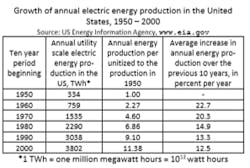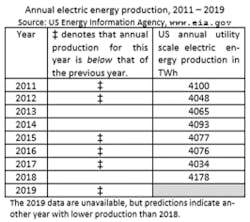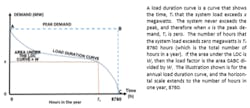Electrification of Applications to Aid Annual Electric Energy Production
The century 1900 to 1999 was widely proclaimed the electric energy century with the U.S. National Academy of Engineering identifying the greatest engineering achievement of the century as being the electrification of the world. It is fair to say that the tremendous advances permitted by the convenient access to electric energy have made possible high levels of manufacturing, communication, computation, significant land transportation, space heating, and cooling, lighting, and other conveniences for humankind.
All of this has come with a modest price per kilowatt hour and an impressive reliability for the most part. It appears that electric power engineers can rightfully take much of the credit for this accomplishment. But if that is so, what has happened to the growth of the electric power industry in recent years? What is the prognostication for the future?
One would think that the many advances of the previous century could only be improved and extended, resulting in further growth of the electric energy industry. It appears that there are additional enhancements in existing applications and further benefits to mankind by new applications and improvements in control, reliability, cost, and efficiency.
What is actually observed is the contrary: the growth of utility scale annual electric energy production in the United States for the half century 1950 to 2000 has slowed. Inspection of gross statistics seems to show a fairly consistent slowing of the growth of electric energy production.
Since the turn of the previous century, the slowing has largely extrapolated to the point that not only has there been little growth in energy production per year, the production of electricity at the utility scale has actually decreased in many of the previous years. How can this be — given the potential of further advances to human activity and relieving man of his burden?
Before proceeding to that question, it is worthwhile to examine the recent annual electric energy statistics. The data appear to show exactly the observation stated above: the annual electric energy production at the utility scale (that is, not including such disbursed, privately owned energy sources such as residential solar photovoltaic (PV) which now (2019) exceeds 1% of annual electric energy generation in the United States) has, in the period 2011 to 2019, decreased than the previous year in every year except for three (that is, in the eight annual totals in this recent interval, five annual energy production levels were lower than the previous year). And the data for 2019, although not yet available, indicate that production in 2019 will be below that in 2018. While slowing growth may be unnerving considering reduction in annual profits to investors in this industry, reduction in production is further problematic in the sense that existing invested assets, generation, transmission, and distribution may not be used at capacity. What further compounds these observations is that annual load factor in many places in North America is in the 50% range (the load factor is the ratio of annual energy served to the total energy that would be produced if generation operated 24x7 at the annual peak). In effect, the load factor is onemeasure of the efficacy of using the installed assets. Needless to say, the 50% figure is not impressive.
What are the reasons for the sluggish (if not negative) growth in large-scale electric energy production? What happened to the ‘economy of scale’? The implementation and widespread commercialization of residential PV electric energy production is an obvious factor. Other explanations are depressed energy consumption during economic recessions and improvement in energy use efficiency (especially in transformers of all sizes, machine drives, space heating/cooling, and considerable improvement in the efficiency of new technologies of electric lighting). Nonetheless, with the promise of considerable further improvements in manufacturing, new applications of electric energy use, and, indeed, in human life, one would expect greater growth in the use and concomitant production of electricity.
The list of potential market opportunities for electric power is extensive, ranging from substantial loads and high impact to lesser opportunities. One element that seems to be consistent in many of these application opportunities is the investment intensive requirements for implementation. A second point that seems to be consistent is the element of risk. If a large-scale electrification effort is implemented in a given technology, what are the chances of failure to be successful in commercialization? Another issue is the potentially long term required for some technologies to reach a successful market position. An obvious example is the electric passenger car which has been ‘just around the corner’ since at least 1917. One more issue is that the “longest time constant in the system” is the human time constant: slow acceptance of new technologies.
Many of the newer applications have a further capability to enhance the load factor, that is, using the assets already in place to the best economic efficacy.
The key areas to be developed include:
- Desalination
- Electric vehicles (EVs) (including trucks)
- Rail electrification
- Large-scale energy storage
- Farm applications, animal husbandry, and food processing
- International sales of heavy power equipment and electric energy itself where feasible
- Increased manufacturing opportunities
- Heavy industrial heating
- Recycling of refuse
- Metal recovery (for example, automobile batteries)
- Carbon dioxide (CO2) removal
- Very long-distance transmission of electric energy to take advantages of time zone diversity of use (possibly using high-voltage dc)
- Pharmaceutical production.
Electric power engineers need to make the case for electrification of applications where this “wonder technology” makes sense and where humankind can benefit from the energy intensive, efficient, and controllable nature of this technology. The control and portability of the technology is a strong motivation for these new applications now.
About the Author
Gerald T. Heydt
Dr. Gerald T. Heydt is the site director of the Power Systems Engineering Research Center at Arizona State University and also the site director of a National Science Foundation engineering research center called the Future Renewable Electric Energy Distribution and Management center. Dr. Heydt is the author of two books, one on electric power quality, and the other on computer analysis of power systems. Dr. Heydt’s main interests are: electric power quality, transmission and distribution engineering, power systems modeling and computer control, and the dynamic response of electric power systems.




